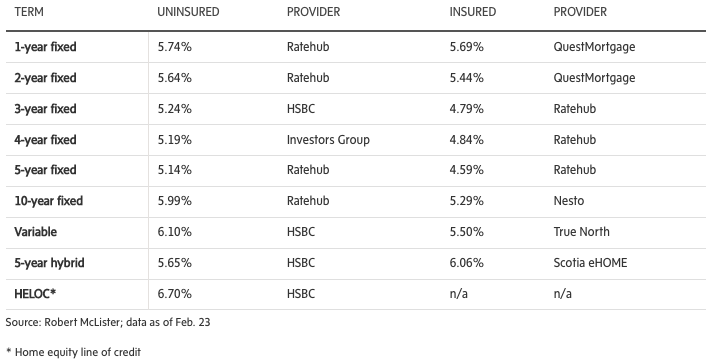
“I can offer you a special rate, but only until Friday.” It’s a line used by countless call centre reps and sales teams at mortgage lenders across the country.

Such lenders like to call up or e-mail people who have a variable-rate mortgage with a warning that “rates are on the rise,” or something to that effect. Then they try to entice worried borrowers with “limited-time offers” to lock in.
And guess what? With a minority of people, it works. So when your friendly banker contacts you out of the blue with such an offer, here are six things to remember.
1. It’s not 2021 any more
Apart from borrowers desperate for payment certainty, locking in no longer has a favourable risk/reward. Prime rate is well over double its 10-year average. When that happens, coupled with forward guidance from the Bank of Canada that it’s pausing rate hikes, odds are good that rates don’t have much further to rise, if they rise at all.
“If you think inflation will subside and/or we are on the verge of recession, stay variable and wait for those prime rate drops,” True North Mortgage chief executive officer Dan Eisner said in an e-mail.
Remember that rate expectations and reality are often two different things. “Mortgage rates are where they are because half the economists believe they should be higher, and half believe they should be lower,” he adds. “It is not because all economists agree.”
2. Consider another term
Lenders love selling five-year fixed rates all day long, but especially near the top of a rate cycle. Five-year contracts are more profitable and earn them big prepayment penalties when rates drop. That essentially binds most customers to the lender.
In turn, steep penalties limit one’s refinance potential. That can leave you with only your existing lender’s refinance options, which may be limited, and/or leave you paying more interest than necessary.
Long story short, in a case where you’re concerned about rising rates, don’t want to commit five years (because rates may fall) and a lender pitches you on a five-year fixed, ask for a shorter term instead. And tell them you want a similarly competitive rate.
“Five years is a long time to be locked in when rates are nearing their peak,” says Ann Pope, a mortgage agent of 23 years from Premiere Mortgage Centre. “Life events can trigger a move resulting in potentially significant prepayment penalties.” Opting for a three-year fixed instead of a five-year fixed, for example, could make a bank’s penalty far less costly, she says.
3. Consider another provider
If you’re in a variable mortgage, odds are you only have to pay three months of interest to ditch your lender early. If you’re getting a materially lower rate elsewhere, it may be worth it.
Suppose you have a $400,000 mortgage at 5.7 per cent, for example. That’s roughly a $5,700 prepayment charge to leave. If your lender’s rate is significantly higher than your best alternative, it might make sense to pay that cost, break the mortgage and move. It could also make sense if breaking lets you consolidate other high-cost debt or take out equity for another worthwhile purpose.
Speaking of changing lenders, “The potential new OSFI rules will make switching lenders more difficult and time-consuming in the future,” Mr. Eisner says. If you’re someone whose debts are a high percentage of their income, for example, he suggests that “it might be your best bet to renegotiate your mortgage now before you lose the ability to threaten to switch lenders.”
4. You often don’t have to rush
Some lenders use high-pressure tactics to create a false sense of urgency. Unless bond yields – which lead fixed mortgage rates – are going straight up, a lender’s fixed rate will potentially be available after their claimed deadline.
As of late, yields have been climbing, however. Therefore, if a lender gives you a response deadline, ask two questions:
“Are the lender’s rates going up for all potential customers on that date?” If not, there may be more leeway on timing.
“I need more time to think about it; can you give me another week?” Take the time they give you to shop around. For fast advice, call an experienced independent mortgage adviser and ask them to calculate what mortgage changes make sense.
5. Drive a hard bargain
Just because a lender proposes a limited-time special doesn’t mean its rate can’t get more “special.”
Call a mortgage broker for more quotes, scan online rate sites, check The Globe and Mail’s “Lowest nationally available mortgage rates” rate table and use lower rates as leverage when appropriate.
And if another provider quotes a much lower rate – up front – for a better product, try to reward their efforts with your business. Lenders who play games by highballing you, only to drop rates when you catch them, usually don’t deserve the business.
6. Consider your odds of approval
“For a less-qualified client, rate stability matters, especially if income isn’t keeping up with inflation,” Ms. Pope says.
Moreover, if it’s unlikely you can qualify elsewhere because of income loss, credit problems or otherwise, and locking in makes sense for your situation, taking your existing lender’s offer might make sense.
On the other hand, for a well-qualified client with enough savings to accommodate higher payments, “I would recommend not converting at all,” she says.
Borrowing costs reinflate
Once again, fixed mortgage rates under 5 per cent have done a disappearing act, at least for uninsured mortgages.
It happens, though. Rates are volatile after inflation peaks. Fixed rate mortgages below 5 per cent will almost certainly be back later this year – once the bond market starts pricing in a downturn more imminently.
The catalyst for this latest upward move has been a worrisome bout of inflationary economic data. That’s ushered bond yields higher, which pushes bank funding costs higher, which in turn drives fixed mortgage rates higher.
As a result, a slew of fixed rates took the up-escalator this week. The cheapest nationally-available five-year fixed rate, for example, is now 25 basis points higher than it was last week. The lowest insured one-year fixed is now 105 basis points higher. (A basis point is 1/100th of a percentage point.)
On top of this, we’ve also seen a few major banks trim their floating-rate discounts in recent weeks. Par for the course is now prime rate minus 0.3 percentage points (6.4 per cent) for uninsured Big Bank variable rates. Although you’ll find cheaper options in the table below.
Insured variable rates, which benefit from low-cost securitization, are much lower. They start around prime minus 1.2 percentage points (5.5 per cent), or thereabouts.
If the market is right about two things – the economy buckling under rate pressure and the Bank of Canada having to drop rates next year – riding down an insured floating rate could save you some money. Not so much in the case of uninsured variables.
Lowest nationally available mortgage rates

Rates are as of Feb. 23, 2023 from providers that advertise rates online and lend in at least nine provinces. Insured rates apply to those buying with less than a 20 per cent down payment, or those switching a pre-existing insured mortgage to a new lender. Uninsured rates apply to refinances and purchases over $1-million and may include applicable lender rate premiums. For providers whose rates vary by province, their highest rate is shown.
Robert McLister is an interest rate analyst, mortgage strategist and editor of MortgageLogic.news. You can follow him on Twitter at @RobMcLister.
Comments are closed.
